Pancreas enlargement Is a pathological condition of the tissues of a given organ of the endocrine system, the cause of which is the presence of acute or chronic inflammation. Pathological and general factors are distinguished, the influence of which can provoke hyperplasia of all or individual segments of the pancreas.
As the tissues of this organ increase, the inflammatory process progresses, signs of edema are more and more clearly manifested. A characteristic symptom of pathological hyperplasia of the pancreas is the presence of acute or spasmodic pain, which is localized in the left hypochondrium with a slight displacement to the center.
There is a whole group of severe diseases of the endocrine system, the presence of which can provoke an increase in the tissues of the pancreas. Moreover, they are all accompanied by an inflammatory process and methodical destruction of the organ structure. Under conditions of pathological enlargement of the pancreas, its functional activity decreases.
The glandular tissue of the organ continues the synthesis of digestive enzymes, but at the same time the process of their release into the duodenal cavity stops. In this regard, the effect of self-digestion of the pancreas occurs with the manifestation of even more acute signs of inflammation. Against this background, edema continues with a pathological increase in the tissues of this organ.
Most of the enzymes, as well as biochemical substances of toxic etiology, which accumulate in the cells of the pancreas, are distributed throughout the body along with the blood stream. This leads to the appearance of the effect of general intoxication, and also increases the risk of damage to the structure of the tissues of the heart, the walls of blood vessels, and the liver.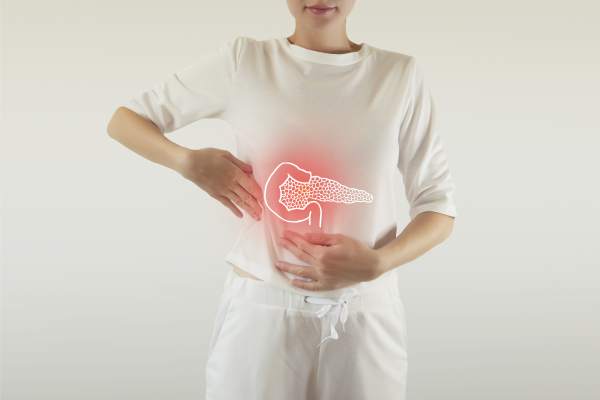
An enlargement of the pancreas, accompanied by an inflammatory process, requires an early start of drug and enzymatic therapy in compliance with strict dietary rules. The main danger of hyperplasia of this organ is the high probability of developing severe complications that can lead to death.
Record content:
-
1 Views
- 1.1 Edematous
- 1.2 Destructive
-
2 Stages of the disease
- 2.1 Enzymatic
- 2.2 Reactive stage
- 2.3 Focal necrosis
- 2.4 Chronization of the pathological process
- 3 Symptoms and Signs
- 4 Causes
- 5 Diagnostics
-
6 Treatment methods
- 6.1 Pancreatin
- 6.2 Pangrol 10000
- 6.3 Micrasim
- 6.4 Diet therapy according to Pevzner No. 5p
- 7 Possible consequences and complications
- 8 Pancreas video
Views
An increase in the pancreas (the causes of the pathological condition of the tissues are determined by the results diagnostic examination) is always accompanied by her extensive edema, which causes a constant feeling discomfort. There are several types of hyperplasia of this organ of the endocrine system, each of which has its own classifying features.
Edematous
This type of pathology is characterized by a local inflammatory process with hyperplasia of individual parts of the organ. In this case, damage to a minimum number of pancreatocytes is observed without signs of necrosis development.
An enlargement of the pancreas of the edematous type is considered the initial stage of the development of a painful state of the organ. In the case of timely initiation of therapy within 15 days, it is possible to stabilize the functional activity of the inflamed tissues, as well as eliminate pathological symptoms.
Destructive
Hyperplasia of this organ of the endocrine system with signs of destruction is characterized by a painful state of its tissues with the appearance of symptoms of necrosis. Perhaps a total defeat of enlarged tissues with the spread of edema and inflammation to all parts of the pancreas, or small focal death of pancreatocytes.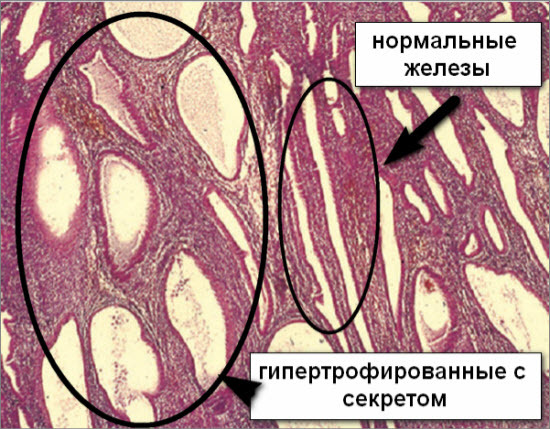
The destructive type of the disease is more dangerous, since it can cause severe and irreversible changes in the structure of an organ with a complete loss of its functional activity. In medical practice, there are clinical cases when in an inpatient department of a medical institutions admit patients with total necrotic destruction of the head, body, and tail glands.
Stages of the disease
An increase in the pancreas (the causes of the painful state of this organ are associated with the presence of concomitant endocrine diseases and the digestive system) develops gradually with the passage of several stages of pathological changes in the structure of the glandular fabrics.
Enzymatic
At this stage of hyperplasia of the pancreas, an increase in the edema of its tissues occurs with a further violation of the enzymatic function. This stage of the disease is characterized by a decrease in activity in the synthesis of enzymes, or the preservation of the process of their production, but with accumulation inside the tissues of this organ.
In this case, the patient begins to complain about the appearance of the first symptoms of an enlarged pancreas, which are rapidly progressing. The enzymatic stage of pancreatic hyperplasia lasts from 3 to 5 days.
Reactive stage
An enlargement of the pancreas, accompanied by an inflammatory process, quickly turns into a reactive stage. This stage in the development of the disease is characterized by extensive edema of all tissues of this organ, the appearance of acute pain, complete loss of appetite.
Patients who are in the reactive stage of pancreatic hyperplasia need urgent medical attention. Otherwise, the persistence of long-term pain syndrome is possible. The average duration of the reactive stage of this pathology is from 6 to 14 days.
Focal necrosis
This stage of pancreatic hyperplasia is always accompanied by an inflammatory process, differs in the death of individual sections of pacreatocytes. At this stage of the development of the disease, the principle of self-digestion of the organ is realized.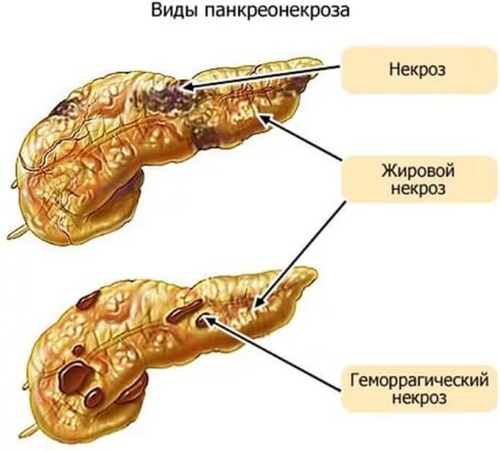
The pancreas partially loses its functions, metabolic decay products that are formed in its tissues have a toxic effect on the entire body of a sick person.
The scale of organ necrosis depends on the reasons that provoked the enlargement of the gland, as well as the quality of drug therapy. The stage of focal necrosis of the pancreas begins from the 15th day from the moment the first signs of hyperplasia appear.
Chronization of the pathological process
In the event that with the help of drugs, diet therapy or other methods of treatment, it was still possible stop the further enlargement of the organ, the inflammatory and necrotic process, then the transition of the disease to chronic form.
At this stage, there is always a risk of exacerbation of the pathological condition of the pancreas with the manifestation of acute symptoms. Patients faced with hyperplasia of this organ are forced to observe dietary restrictions for life. food, completely abandon the use of alcoholic beverages, foods with a high content of simple carbohydrates.
Symptoms and Signs
An increase in the pancreas (the causes of this pathology are associated with the quality of the patient's nutrition) always accompanied by bright and rich symptoms, which increase as the edema spreads further fabrics.
The following signs of hyperplasia of this organ of the endocrine system are distinguished:
- acute and intense pain in the left hypochondrium, which can cover half of the abdominal cavity;
- nausea;
- incessant vomiting (in the absence of food in the stomach, along with vomit, bile is secreted);
- loss of appetite;
- yellowing of the skin and whites of the eyes (this symptomatology appears due to the fact that the liver and gallbladder are involved in the pathological process);
- a change in the color of urine, which acquires a rich brown tint;
- lightening of feces (in most cases, the stool becomes liquid and is gray or completely white).

Symptoms of an enlarged pancreas
When such symptoms appear, the attending physician who examines the patient should suspect a pathological increase in pancreatic tissue, accompanied by an inflammatory process.
More detailed diagnostics using the ultrasound method of research confirms the fact of hyperplasia of this organ of the endocrine system. After that, measures are taken to eliminate painful symptoms and stabilize the general condition of the patient.
Causes
An increase in the pancreas can be caused by the negative influence of external and internal factors, as well as existing diseases of certain organs.
There are the following main reasons for the development of this pathology:
- alcohol abuse (clinical studies have shown that about 70% of people with signs of an increase in pancreatic tissue suffer from chronic alcoholism);
- infectious diseases of the digestive system;
- fungal or viral damage to the tissues of the pancreas;
- poisoning of the body with low-quality food products or chemicals of toxic etiology;
- trauma to the abdominal organs resulting in damage to the tail, head or body of the pancreas;
- dysfunctional disorders in the work of muscles responding to the opening and contraction of the sphincter of Oddi;
- complications that have arisen against the background of cholelithiasis (this cause of pathological organ hyperplasia occurs in 20% of all patients);
- damage to the pancreas by parasitic microorganisms, which cause an increase in its tissues, swelling, the formation of multiple cysts (trematodosis, opisthorchiasis);
- postoperative complications when surgical manipulations were carried out in close proximity to this organ;
- negative consequences of endoscopic diagnostics (this cause of pathological enlargement of pancreatic tissue occurs in 5% of patients);
- congenital hyperplasia of this organ of the endocrine system, which is an abnormality of intrauterine development, or is transmitted along with genetic information from parents to the child;
- unhealthy diet with daily consumption of large amounts of foods containing preservatives, dyes, emulsifiers and other food additives of chemical etiology that are harmful to human organism.
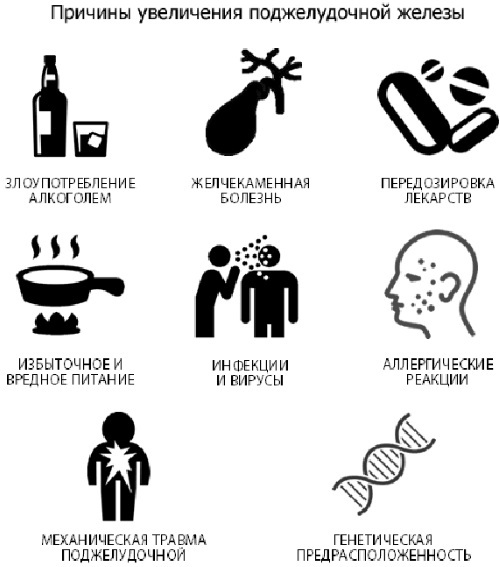
Fatty, smoked and sour foods also have a negative effect on the structure of the glandular tissue, which ultimately leads to its rapid hyperplasia. The reasons that provoked an increase in the pancreas are determined by the results of a diagnostic examination. After this, the stage of eliminating the influence of negative factors begins, as well as the formation of an effective therapy regimen.
Diagnostics
An enlarged pancreas (the causes of the pathology can be determined with the help of a qualitative diagnosis) is detected by a general practitioner, endocrinologist or gastroenterologist. Specialists of this profile can examine patients with signs of hyperplasia of this organ.
Diagnosis of the pancreas begins with an initial examination of the patient and palpation of the left abdominal cavity. If acute and prolonged pain is detected in the hypochondrium on the left, a more thorough examination is prescribed, the methods of which are described in the table below.
| Study type | Description of the diagnostic process |
| Ultrasound | Timely ultrasound examination allows you to quickly and accurately determine the hyperplasia of the pancreatic tissue. This diagnostic method is completely painless, and its duration is from 10 to 15 minutes. The patient takes a horizontal position while on his back. With the help of an ultrasound machine, the doctor examines the structure of the glandular tissue, and also determines its physiological dimensions. The average cost of this diagnostic method is 750 rubles.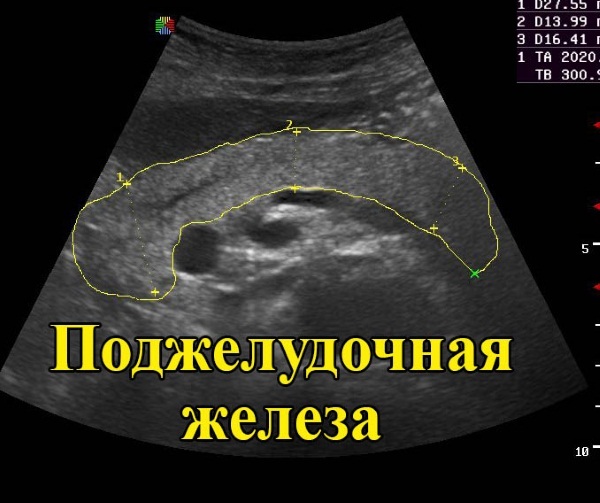 |
| Fibrogastro-duodenoscopy | A special gastroscope equipped with a digital video camera is introduced into the patient's oral cavity. This device is advanced into the esophagus, stomach, and duodenum. During this process, the state of the mucous membrane of the organs of the digestive system is fixed, the presence or absence of digestive enzymes of the pancreas. Fibrogastroduodenoscopy allows you to assess the functional activity of the organ, or to establish its complete absence. The average cost of this diagnostic method varies from 900 to 1250 rubles. |
| Laparoscopy | Laparoscopy is one of the most informative methods of diagnostic examination of the pancreas. The principle of its implementation is that a special telescopic tube is inserted into the patient's abdominal cavity, equipped with a system of lenses connected to a video camera. Penetration into the patient's body is carried out through the anterior wall of the peritoneum. For this, a small surgical operation is performed using local anesthesia. With the help of the laparoscopic diagnostic method, the attending physician gets the opportunity to study the state of the tissues of the pancreas in as much detail as possible, as well as to determine its increased size. The average cost of this type of examination is 6,000 rubles. |
Laboratory methods for diagnosing hyperplasia of this organ of the endocrine system include analysis venous blood for the level of amylase, as well as a biochemical study of morning urine for indicators diastases. According to the results of the examination, the fact of an increase in the tissues of the pancreas is confirmed, or another type of disease with similar symptoms is found.
Treatment methods
The scheme of therapy for pancreatic hyperplasia depends on which factors provoked the pathological state of this organ of the endocrine system. In most cases, a course of taking drugs with enzymatic activity is sufficient, as well as adherence to a strict diet according to Pevzner (table No. 5p).
Pancreatin
Pancreatin is an effective tablet form of drug that contains digestive enzymes in the form of amylase, protease, and lipase.
Taking this medication is indicated for patients in whom an increase in the pancreas is accompanied by dysfunction of the enzymatic activity of the organ, disruption of the process of digestion and assimilation of proteins, fats, carbohydrates. The dosage regimen of Pancreatin is 1-2 tablets, which are taken directly during the meal.
The duration of treatment depends on the severity of the pathology, but in general it can last for several months. The average cost of 1 package of Pancreatin is 25 rubles. for 20 tab.
Pangrol 10000
Pangrol 10000 is an enzyme preparation manufactured by the German pharmaceutical company Berlin-Chemie. Taking this medication is indicated for patients with pathological enlargement of the tissues of the pancreas, which led to a disruption in the production of digestive enzymes.
The drug Pangrol 10000 is taken in 2-4 capsules during breakfast, lunch and dinner. The drug should be taken with 1 glass of water at room temperature. The duration of the therapeutic course is determined by the attending physician. The average cost of the drug Pangrol 10000 is 210 rubles. per pack of 20 capsules.
Micrasim
Micrasim is a drug that replenishes the dysfunction of the pancreas, which consists in the complete or partial absence of its enzymatic activity. The active ingredients of this medication are protease, lipase, and amylase. Micrasim is taken 1 capsule 3 times a day with meals. This medication must be taken with a liquid with a non-alkaline component.
For example, fruit juices or compotes prepared on their basis. The duration of taking Micrasim is from several days to many months, depending on what caused the hyperplasia of the pancreas. The average cost of this drug is 180 rubles. for 20 capsules.
Diet therapy according to Pevzner No. 5p
The principle of adherence to diet therapy according to Pevzner No. 5p is that all food should be steamed, boiled in water or stewed in its own juice without adding fats. A prerequisite is adherence to the principle of fractional nutrition, but in small portions.



Allowed the use of vegetable and cereal soups, which are killed to a state of puree. The patient's diet also includes lean meat and fish, chopped into minced meat or cut into small pieces. Of the fats, only vegetable oils are allowed in a minimum amount, which are used only for dressing vegetable salads.
In the presence of an enlarged pancreas, you can eat dairy and fermented milk products, but only with a reduced level of fat content. On the basis of cottage cheese, it is allowed to cook casseroles, and chicken eggs are consumed only soft-boiled. At the same time, there can be only 1 yolk in the daily diet, since they create an increased load on the tissues of the pancreas.
The menu of a patient with pancreatic hyperplasia should include the following types of cereals:
- rice;
- oatmeal;
- semolina;
- buckwheat.
All cereals are cooked to a jelly-like state in order to minimize the load on the organs of the digestive system. Pasta is also used for food, but only those made from durum wheat.
Possible consequences and complications
The lack of timely detection and treatment of diseases that cause an increase in pancreatic tissue leads to the occurrence of the following complications:
- diabetes;
- portal hypertension;
- jaundice;
- development of concomitant diseases of the liver and gallbladder;
- pancreatic tissue abscess;
- encephalopathy;
- intoxication of the liver, heart, kidneys;
- obstructive jaundice;
- pancreatic necrosis;
- death.
An enlarged pancreas is a painful condition of this organ of the endocrine system, which is accompanied by extensive edema, the presence of acute or chronic inflammation. The main cause of the pathology is alcohol dependence, as well as concomitant diseases of the liver, gallbladder, and gastrointestinal tract organs.
The key to successful treatment of pancreatic hyperplasia is a complete rejection of alcohol, taking enzyme preparations that restore the function of a diseased organ and adherence to the rules of dietary nutrition. All foods eaten should be free of simple carbohydrates and large amounts of vegetable and animal fats.
Pancreas video
Pancreatitis treatment + diet:



